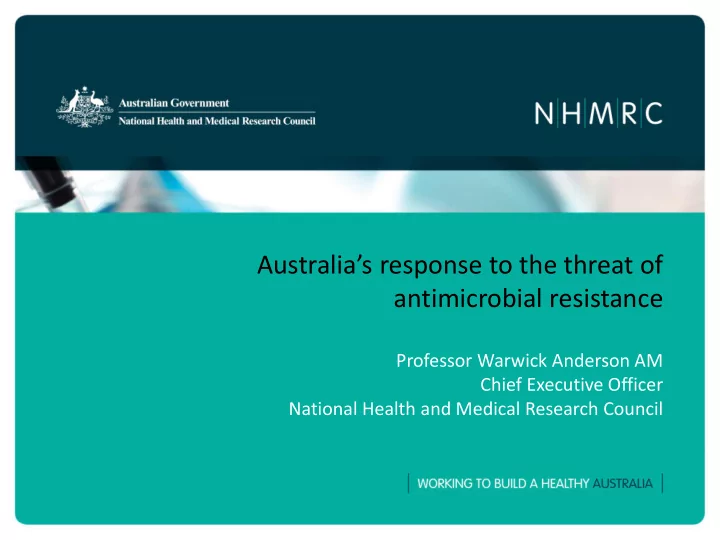

Australia’s response to the threat of antimicrobial resistance Professor Warwick Anderson AM Chief Executive Officer National Health and Medical Research Council
Australia’s health system
Antimicrobial resistance in Australia • Antibiotic usage remains relatively high in Australia, however levels of resistance are lower than many other countries. • Resistant bacteria that were once primarily the concern of hospitals are now seen frequently in the community. • Not uncommon for patients to arrive at hospital carrying resistant bacteria acquired in the community setting. • Levels of community acquired resistance are very high in some disadvantaged communities, especially Aboriginal and Torres Strait Islander communities.
AMR surveillance in Australia • Emergence and epidemiology of AMR is determined by complex interaction of environmental, epidemiological, clinical and behavioural factors in humans, animals and agriculture • Therefore, need surveillance data from animals (including companion animals) and agriculture • Information on bacterial isolates and their antibiotic resistance patterns is collected in most large teaching hospitals, currently there is little national coordination of data • Little collection of data for community-acquired resistance or in agriculture or food production • Such national data are critical to coordinated AMR surveillance systems
Australian National AMR Prevention and Containment Strategy (the Strategy) • Australian Government recognises that responding effectively to AMR involves a combination of “regulation, monitoring and surveillance, targeted activity on specific organisms, research and education”* • The Strategy is an important step in Australia’s response • Includes an integrated national surveillance system for antibiotic resistance and antibiotic usage across the human health and agriculture (‘one health’ approach) • High Priority - the Strategy Steering Group is jointly Chaired by the Secretaries of the Health and Agriculture Departments • In the 2013/14 budget the Australian Government allocated A$11.9m over three years to implement the Strategy* *(http://www.safetyandquality.gov.au/wp-content/uploads/2013/07/Briefing-paper-for-One-Health-AMR- Colloquium-participants-Final-Jul-2013.pdf)
National Health and Medical Research Council Act 1. Raise the standard of individual and public health throughout Australia 2. Foster the development of consistent health standards between the States and Territories 3. Foster medical research and training and public health research and training throughout Australia 4. Foster consideration of ethical issues relating to health
Objective Three: Foster medical research and training and public health research and training throughout Australia • Most NHMRC research funding is investigator-initiated and, as with other developed nations, there is pressure to maintain the success rate. • In the last ten years, NHMRC funding for research involving antimicrobial resistance has increased almost ten-fold (≈ A$1.0m across 13 grants in 2002-03 to ~A$9.7m across 65 grants in 2012-13). • This is a small proportion of total NHMRC funding (total ≈ A$0.8b in 2013). • NHMRC’s Strategic Plan identifies New and emerging health threats as a current strategic priority for the organisation. This will encourage investigator-initiated applications relevant to infectious diseases (including antimicrobial resistance) to be submitted to NHMRC.
Examples of NHMRC funded research in AMR 1. Minimising Antibiotic Resistance for Acute Respiratory Infections CRE, Bond University - Prof Chris del Mar, Prof Paul Glasziou, Prof John Lowe, Prof Mieke van Driel Focus on the major contributors to resistance: antibiotic overuse and person-to-person transfer of antibiotic resistance genes, and inform the design, evaluation and translation of urgently needed interventions. 2. Mechanisms of Disease Caused by Hospital-Acquired Pathogens Career Development Fellowship, Monash University - A/Prof Anton Peleg Key aim of A/Prof Peleg’s work is to develop novel antimicrobials. Shorter-term research objectives include “assessing the role of Staphylococcus aureus bacterial evasion mechanisms in antibiotic resistance and host- pathogen interactions”. On 7 June 2013, A/Prof Peleg was awarded the Commonwealth Health Minister’s Award for 2013. 3. Optimising the Use of Antimicrobials in the Intensive Care Setting TRIP Fellowship, Royal Melbourne Hospital - Dr Nadia Chaves Address the gap between the optimal and current prescribing practices in ICU through implementation of an antimicrobial stewardship package. Aim - reduce inappropriate use of antimicrobials to prevent development of resistance and improve patient outcomes.
Research translation Australian Government agencies work together to promote consistent messages about appropriate use of antibiotics in human and animal health Pharmaceutical Benefits Scheme - antibiotics of last resort require ‘authority’ to prescribe TGA (Australian equivalent of the FDA) Therapeutic guidelines: Antibiotic, Version 14. 2010 National Prescribing Service (NPS) has a campaign each year to reduce AMR (2013 - No action today, no cure tomorrow ) Nature,12 June 2008, 453 :840-842 In approving antibiotics for use in animals, the Australian Pesticides and Veterinary Medicines Authority (APVMA) consider implications for resistance to human antibiotics and can impose restrictions
Ideas for international collaborative research Basic biology • collaboration in regard to specific bacteria. Researchers know their natural partners across the world. Epidemiology • resistance patterns in human bacterial microbiomes in different populations, e.g. International Human Microbiome Consortium. • epidemiology of resistance as a result of international travel. Surveillance • international data on AMR and antimicrobial use in humans from healthcare facilities and the community - impact of usage patterns on the development of bacterial resistance to inform action. • international data on number and outcomes of patients infected with resistant bacteria to enable early notification in relation to emerging and re- emerging highly resistant bacteria. • linking resistance data from humans, animals and food to provide an international picture of AMR to guide action.
Continued… Diagnostics • International collaboration to develop rapid diagnostic tools New antibiotics • International collaboration to investigate novel research models, e.g. public/private partnerships. • International collaboration to develop novel antibiotic agents (e.g. drugs design using genomic approaches Health services research • research into health services that assist in the avoidance and reduction of resistance requires further collaboration at the researcher level.
www.nhmrc.gov.au
Recommend
More recommend